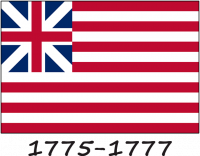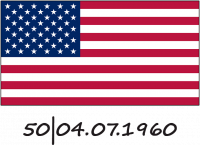The first flag similar to the modern star-spangled banner was an unofficial flag sometimes called the Great Union Jack or "continental colors." It had 13 red and white stripes, with a Union Jack in the upper left corner. This flag was raised on December 3, 1775, by Continental Navy Lieutenant John Paul Jones aboard the USS Alfred. It remained the national flag until June 14, 1777. The Second Continental Congress in 1776 decided to adopt flags with "stars white on a blue field". The "Grand Union Jack" became the first national flag of the United States. The Continental Navy probably transformed its previous British red flag by adding white stripes.

Starting in 1777, the Union Jack flag was removed from the canton and replaced with 13 white five-pointed stars on a blue background. 13 stars according to the number of states that were part of the United States of America at that time.

Since the placement of the stars was not fixed and standardized anywhere, there were various variants of their placement, the main rule was only their number - 13: Connecticut, Delaware, Georgia, Maryland, Massachusetts, New Hampshire, New Jersey, New York, North Carolina, Pennsylvania, Rhode Island, South Carolina, Virginia.

The stars in this number existed for 18 years, until two more were added in honor of Vermont and Kentucky, and later 5 more - Tennessee, Ohio, Louisiana, Indiana, Mississippi. For all the changes to the flag with the addition of stars, the number of stripes changed only once. Absolutely all flags consisted of seven red and six white stripes, i.e. the total number of stripes was 13. This is due to the fact that there were originally 13 states, so it was decided that there should also be 13 stripes and stars. And when two stars were added to Vermont and Kentucky in 1795, the stripes were added according to the same principle, resulting in 15 stars and 15 stripes. However, in 1818, it became clear that this system would not work forever, and already at the stage of 20 stripes, it was difficult to place them. Therefore, from 1818 to the present day, the number of red and white stripes has been 13, and with each new expansion, only the number of stars increased.

On December 3, 1818, Illinois joined, so in 1819 there were 21 stars. On December 14, 1819, Alabama joined, on March 15, 1820, Maine joined, and on August 10, 1821, Missouri joined, increasing the number to 24.

On June 15, 1836, Arkansas joined, and on January 26, 1837, Michigan joined.

March 3, 1845 - Florida, December 29, 1845 - Texas, December 28, 1846 - Iowa.

May 29, 1848 - Wisconsin, September 9, 1850 - California, May 11, 1858 - Minnesota.

February 14, 1859 - Oregon, January 29, 1861 - Kansas.

June 20, 1863 - West Virginia, October 31, 1864 - Nevada.

March 1, 1867 - Nebraska, August 1, 1876 - Colorado.

November 2, 1889 - North Dakota, November 2, 1889 - South Dakota, November 8, 1889 - Montana, November 11, 1889 - Washington, July 3, 1890 - Idaho, July 10, 1890 - Wyoming, January 4, 1896 - Utah.

November 16, 1907 - Oklahoma, January 6, 1912 - New Mexico, February 14, 1912 - Arizona, January 3, 1959 - Alaska.

And finally, the last accession to date took place on August 21, 1959 - Hawaii, increasing the number of stars on the flag to 50. In this form, the flag has existed for more than 60 years and is the longest used flag of the USA. It was preceded by a flag with 48 stars, which was used for 47 years from 1912 to 1959, and with 15 stars for 23 years from 1795 to 1818.
















